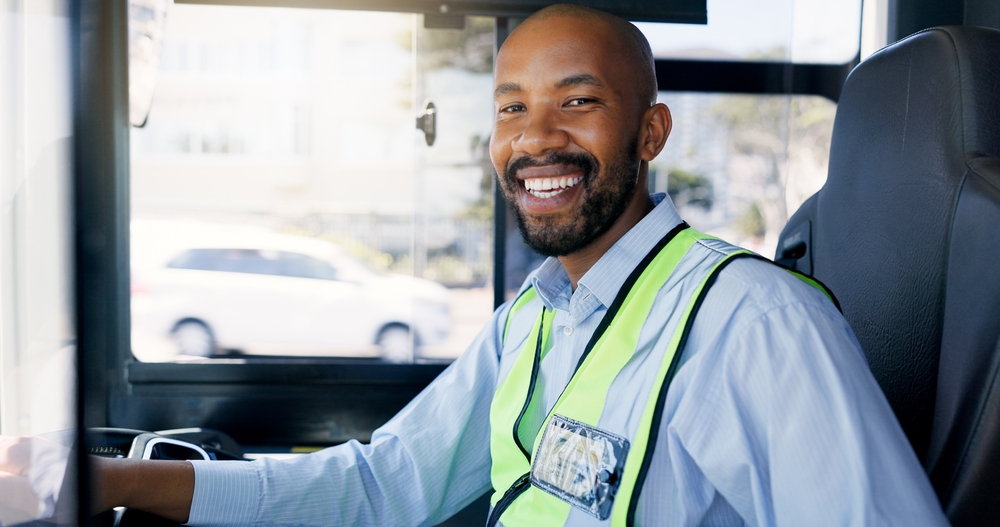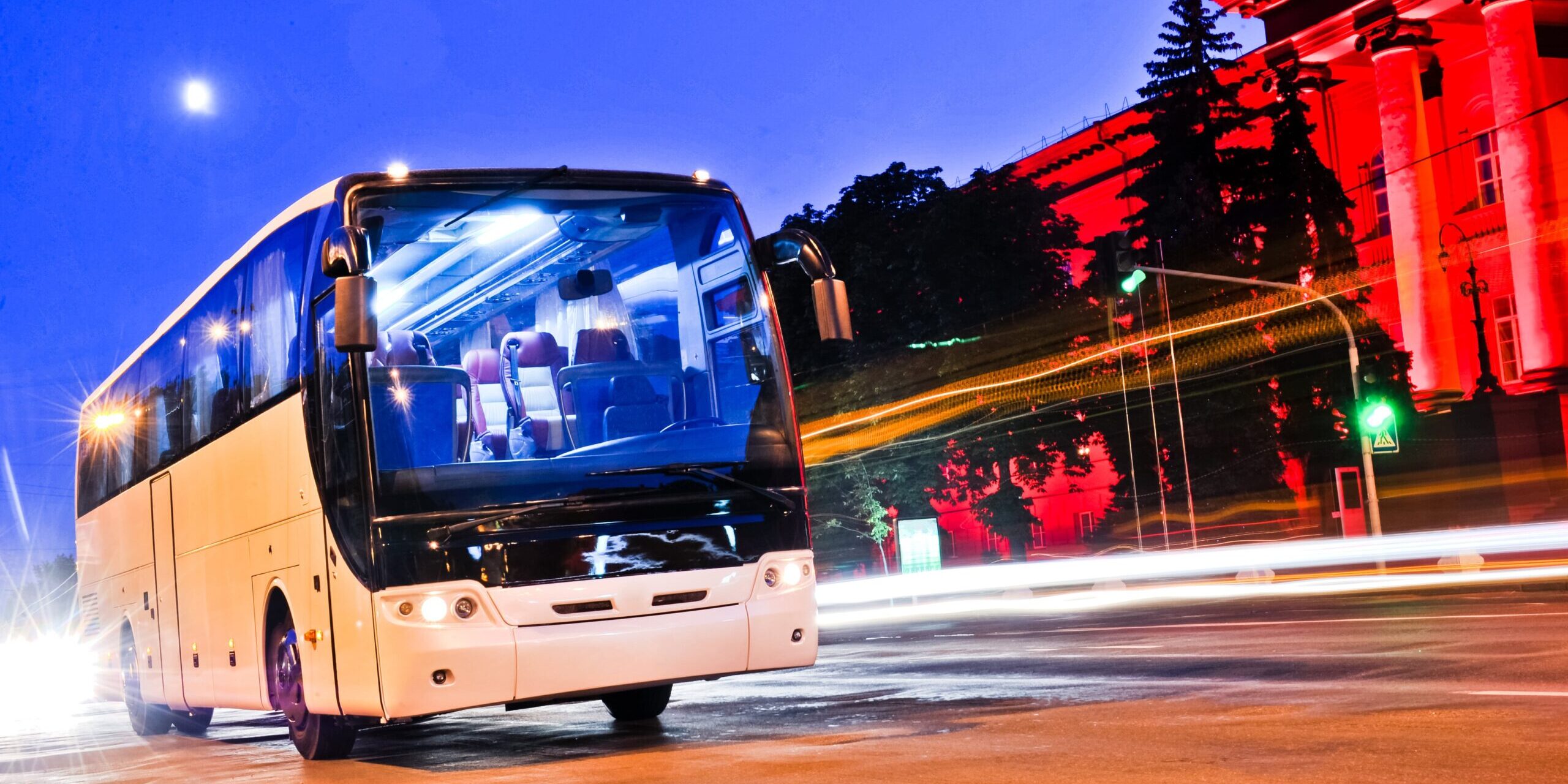When you hear the word “bus,” you might think of a yellow school bus, a crowded city shuttle, or a large vehicle designed simply to move people from one place to another. But not all buses are the same.
One distinction in the transportation world is the difference between a bus and a coach bus; two vehicles that may look similar at a glance but serve very different purposes.
Whether you’re a funeral director, corporate fleet manager, event planner, or tour operator, understanding these differences can help you make smarter decisions when upgrading or expanding your fleet.
In this blog, CoachWest covers everything you need to know about the difference between a bus and a coach bus, from amenities and ride quality to California licensing requirements and today’s best luxury options!

Defining the Basics
What is a Bus?
A bus is typically designed for short-distance, high-capacity transport. These vehicles prioritize efficiency over comfort, making them ideal for daily use. Examples include:
- City buses: Built for frequent stops and maximum passenger capacity
- School buses: Focused on safety and affordability
- Shuttle buses: Used for quick transport between short distances (like hotels and airports)
These vehicles are affordable and functional, but they offer few amenities—no restrooms, limited storage, and simple bench-style seating.

What Is a Coach Bus?
A coach bus (also known as a motorcoach or executive bus) is designed with long-distance comfort and professionalism in mind. These buses are frequently used for:
- Corporate and executive travel
- VIP and celebrity transport
- Funerals and memorial services
- Guided tours and weddings
Coach buses include plush seating, climate control, restrooms, entertainment systems, and luggage compartments. They don’t just transport passengers—they elevate the experience.
Key Differences Between a Bus and a Coach Bus
Seating Capacity and Layout
- Bus: Bench seating, upright design, minimal legroom. Standing passengers are often accommodated.
- Coach Bus: Wide reclining seats, additional spacing, and layouts optimized for comfort on trips lasting several hours.
Comfort and Amenities
- Bus: No climate control, restrooms, or entertainment systems. Built for functionality, not comfort.
- Coach Bus: Amenities may include climate control, restrooms, Wi-Fi, outlets, TVs, and USB charging ports.
Ride Quality and Suspension
- Bus: Built for stop-and-go driving with stiffer suspension.
- Coach Bus: Designed for long highway trips, offering a smoother ride with enhanced suspension and noise reduction.
Uses and Applications
- Bus: City commuting, school transport, local shuttles.
- Coach Bus: Long-distance corporate trips, charter tours, VIP events, luxury travel, and funeral processions requiring dignified, comfortable transport.

Here’s a quick side-by-side comparison that highlights the main differences between a standard bus and a coach bus:
| Feature | Standard Bus | Coach Bus (Luxury/Executive) |
| Primary Use | Short-distance, public or school transport | Long-distance, corporate, funeral, VIP travel |
| Seating | Bench or upright, minimal legroom | Reclining seats, extra spacing, premium finishes |
| Amenities | Few or none (no restroom/tech) | Restrooms, Wi-Fi, power outlets, A/C, entertainment |
| Ride Quality | Basic suspension, noisier ride | Smooth suspension, quieter cabin |
| Storage | Limited or none | Overhead + undercarriage luggage space |
| Licensing | CDL (varies by type/size) | CDL with passenger endorsement (Class B in CA) |
| Passenger Experience | Functional, no frills | Comfortable, professional, high-end |

What License Do You Need to Drive a Coach Bus?
Driving a coach bus isn’t the same as operating a school bus or shuttle. In most cases, you’ll need a commercial driver’s license (CDL) with a passenger endorsement.
Federal Requirements: At the national level, drivers must hold a CDL with a passenger endorsement (CDL-P) if the vehicle transports more than 16 passengers
California Requirements: In California, specific rules apply based on vehicle size and passenger count:
- A Class B CDL with a passenger endorsement is required to drive most coach buses
- For smaller buses carrying fewer passengers, different licensing rules may apply
For businesses in California, especially in Los Angeles, compliance is mandatory. Whether you’re managing funeral processions or transporting corporate clients, licensed drivers protect both your passengers and your reputation.
Best Luxury Coach Buses for Sale in the U.S.
Coach buses aren’t one-size-fits-all. Modern luxury and executive coach buses are tailored to the needs of professionals who expect more than basic transportation. Many models available through CoachWest include:
- Leather reclining seats with extra spacing
- ADA accessibility options
- Climate-controlled interiors
- Restrooms for long-distance trips
- Wi-Fi, power outlets, and entertainment systems
- Ample luggage storage
These vehicles are an ideal choice for:
- Funeral directors who require dignified procession transport
- Corporate travel managers arranging comfortable group travel
- Tour operators offering premium guest experiences
- Event planners coordinating weddings or VIP services.
Explore our Executive & Luxury Buses
Choosing Between a Bus and a Coach Bus
So which option is best for you?
Choose a Bus if:
- You need an affordable option for short, routine trips
- Comfort isn’t a top priority
- You’re transporting students or local commuters
Choose a Coach Bus if:
- Your passengers expect a higher standard of service
- You operate long-distance routes or luxury tours
- You need dignified vehicles for funerals or professional events
- You want to project reliability, comfort, and prestige
For California businesses, especially in Los Angeles, coach buses are often the smarter long-term investment. They don’t just move passengers; they deliver the comfort, reliability, and professional image that today’s clients expect.

Frequently Asked Questions
How many passengers fit in a coach bus?
A full-size coach bus generally seats 40–60 passengers. Smaller executive coaches can carry 20–30 passengers comfortably.
Are coach buses more expensive than regular buses?
Yes, the upfront investment is higher, but coach buses offer better resale value, comfort, and passenger satisfaction, making them more cost-effective for premium services.
Can coach buses be customized?
Absolutely! CoachWest offers customization, from leather seating and branding to onboard technology.
What are the most common uses for executive coach buses in California?
Funerals, corporate shuttles, celebrity/VIP events, weddings, sports teams, and guided tours.
What license do I need to drive a coach bus in California?
You’ll need a Class B CDL with a passenger endorsement. See the California DMV CDL guidelines for details.
Explore Luxury and Executive Coach Buses at CoachWest
For over 35 years, CoachWest has helped professionals across California and beyond upgrade their fleets with executive coaches, funeral vehicles, Sprinter vans, and specialty vehicles.
If you’re ready to add comfort, reliability, and prestige to your business, we’re here to help. Contact us or call today at 310-609-2900 for more information!









